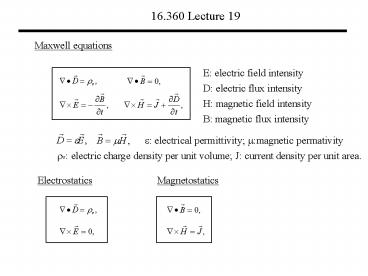16.360 Lecture 19 - PowerPoint PPT Presentation
Title:
16.360 Lecture 19
Description:
16.360 Lecture 19 Maxwell equations E: electric field intensity D: electric flux intensity H: magnetic field intensity B: magnetic flux intensity – PowerPoint PPT presentation
Number of Views:59
Avg rating:3.0/5.0
Title: 16.360 Lecture 19
1
16.360 Lecture 19
Maxwell equations
E electric field intensity
D electric flux intensity
H magnetic field intensity
B magnetic flux intensity
? electrical permittivity ?magnetic
permativity
?v electric charge density per unit volume J
current density per unit area.
Electrostatics
Magnetostatics
2
16.360 Lecture 19
Electrostatics
Volume charge density
Surface charge density
Line charge density
3
16.360 Lecture 19
Current density J
4
16.360 Lecture 19
Coulombs law
5
16.360 Lecture 19
Electric field due to a charge distribution
6
16.360 Lecture 19
Gausss law
Gausss law
7
16.360 Lecture 19
Electrical scalar potential
8
16.360 Lecture 19
Electrical potential due to point charge
Electrical potential due to continuous
distributions
9
16.360 Lecture 19
Electric field as a function of Electrical
potential
Poisons equation
Poisons equation
Laplaces equation
10
16.360 Lecture 19
Electrical properties of material
- conductor
- dielectric
- semiconductor
11
16.360 Lecture 20
Conductors
Electron drift velocity
Hole drift velocity
Conducting current
Point form of Ohms law
12
16.360 Lecture 20
Resistance
General form
13
16.360 Lecture 20
Joules law
General form
14
16.360 Lecture 20
Dielectrics
Electrical field induced polarization
15
16.360 Lecture 20
Dielectrics
P electric polarization field
For homogeneous material
Electric susceptibility
Relative permittivity
Dielectric breakdown
16
16.360 Lecture 20
Electric boundary condition
the tangential component is continuous across
the boundary of two media.
17
16.360 Lecture 20
Electric boundary condition
the normal component of D changes, the amount of
change is equal to the surface Charge density.
18
16.360 Lecture 20
Dielectric-Conductor boundary
19
16.360 Lecture 20
Conductor-Conductor boundary
20
16.360 Lecture 20
Capacitance
21
16.360 Lecture 20
Electrostatic Potential Energy
Image Method
Any given charge above an infinite, perfect
conducting plane is electrically equivalent to
the combination of the give charge and its image
with conducting plane removed.































